-
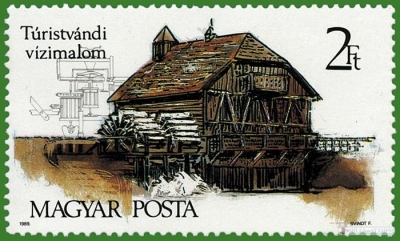
Number by catalogue: Michel: 4028 Yvert: 3217 Scott: 3182
Subject:
2 forints. Watermill in Turistvandi*
Additional:
*Túristvándi is a village in Szabolcs-Szatmár-Bereg county, in the Northern Great Plain region of eastern Hungary.
Photo is from Wikipedia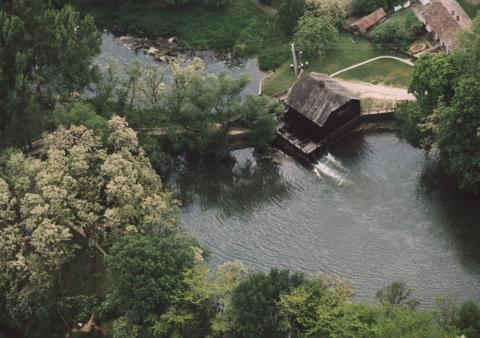
-
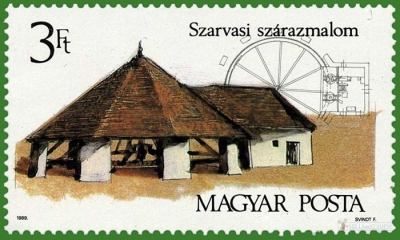
Number by catalogue: Michel: 4029 Yvert: 3218 Scott: 3183
Perforation type: 12 ¼x12
Subject:
3 forints. Horse-driven mill in Szarvas*
Additional:
*Szarvas (German: Sarwasch, Slovak: Sarvaš) is a town Békés county in southeastern Hungary. The Hungarian placename Szarvas means 'deer' on English.
Town with 18,000 inhabitants on the bank of the backwaters of the river Körös. During the Turkish rule it was a popular river crossing place. As early as 1732 market town rights were obtained and significant progress followed due to the Slovakian settlers. In the development of the town the activity of the Lutheran pastor, Sámuel Tessedik was of paramount importance. He introduced reforms in agriculture and town-planning.
The horse-driven mill (also known like arena mill) built in 1836 is a major item in the history of the industry.
In the town you can find the Memorial Road leading to the little windmill symbolizing the middle of the historical Hungary, with wooden statues commemorating the important events of Hungarian history.
-
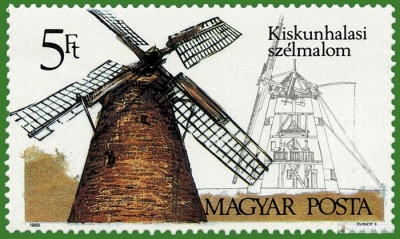
Number by catalogue: Michel: 4030 Yvert: 3219 Scott: 3184
Perforation type: 12 ¼x12
Subject:
5 forints. Windmill in Kiskunhalas*
Additional:
*Kiskunhalas is a town in Bács-Kiskun County, Hungary.
Kiskunhalas is located 130 km (81 mi) south of Budapest.
Its history goes back to the 800s. Kiskunhalas has many archaeological artifacts that are on display in the János Thorma Museum. Since 895 several villages existed in the area. The first written documents mentioning Halas date back to 1347. After 1596 the town lost much of its population. In the 16th and 17th century, Kiskunhalas welcomed the Protestant Reformation. Until 1754 it was the center of the region, but after that it has been declined its rights because of the local people's support for Protestantism. A Roman Catholic church was built in 1770, and a new Presbyterian one in 1823. In 1910 the population reached 25,000.
Kiskunhalas used to be surrounded by lakes that were rich in fish, "Halas" in Hungarian, and this gave rise to the town's name. The other part of the name comes from the Hungarian kiskun-, meaning Little Cumania (Hungarian: Kiskunság).
Croats in Hungary call this town as Olaš. The Croat name "Olaš" came as shortening of Hungarian name "Halas", since it was easier for Croat speakers to pronounce it that way.
On the stamp - The windmill of Sarfik, still active as an electric mill, is a rare piece of industrial history.
Photo is from flickr
-
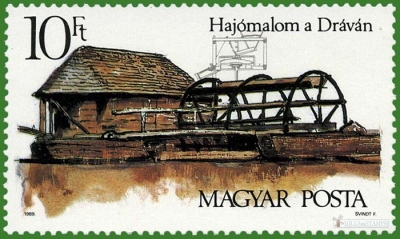
Number by catalogue: Michel: 4031 Yvert: 3220 Scott: 3185
Perforation type: 12 ¼x12
Subject:
10 forints. Watermill-boat on river Drava*
Additional:
*Drava or Drave (German: Drau; Italian, Croatian, and Slovene: Drava; Hungarian: Dráva) is a river in southern Central Europe, a tributary of the Danube. It begins in Dobbiaco, Italy, and flows east through East Tirol and Carinthia in Austria, into Slovenia (145 km), and then southeast, passing through Croatia and forming most of the border between Croatia and Hungary, before it joins the Danube near Osijek.
Exists also imperforated issue
Old mills
Hungary 1989.06.20
In issue: Stamp(s): 4